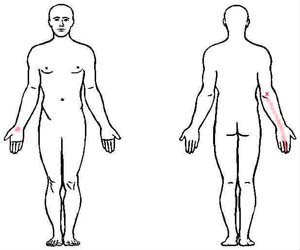
Extensor Digitorum Trigger Points
Extensor Digitorum Trigger Point
The origin of the extensor digitorum is the lateral epicondyle (common extensor tendon). The insertion is located at the extensor expansion of middle and distal phalanges of the 2nd, 3rd, 4th, and 5th fingers. The extensor digitorum muscle is innervated by the radial nerve.
Trigger points refer pain to the middle finger appear most often. Pain from this extensor TrP radiates down the dorsal forearm and causes concentrated pain in the middle finger. Trigger points in the middle extensor are also known to occasionally send referring pain to the frontal or "volar" part of the wrist. The image below shows the referred pain pattern of this TrP, with the middle finger in dark red, showing the most pain.
Conservative Treatments
Therapeutic treatments for addressing soft tissue injuries involve massage therapy, manual therapy, trigger point therapy, Graston Technique, or Active Release Technique. These treatments increase blood flow, decrease muscle spasms, enhance flexibility, speed healing, and promote proper tissue repair.

When these treatments are incorporated into a treatment plan patients heal faster and are less likely to have long-term pain or soft tissue fibrosis or scar tissue in the injured muscle. These soft tissue treatments are incorporated with therapeutic exercise and flexibility programs.
Elbow injuries often occur in people with severe or chronic shoulder injuries. People begin trying to alter their shoulder motions to protect it. Unfortunately these altered body mechanics tend to overwhelm the muscles and tendons around the elbow. People often develop a secondary cubital tunnel syndrome, lateral epicondylitis, tricep tendonitis, medial epicondylitis, pronator teres syndrome, double crush, carpal sprains, wrist tendinitis, de quervain's tendonitis, finger extensor strains, or carpal tunnel syndrome.
Treatment for elbow injuries can be extensive if the tendinosis is severe. Mild strains can be treated at home with PRICE, home stretches, and exercises. Don’t wait for damage to both the shoulder and elbow to seek treatment and therapy.
Medical Treatments
NSAIDs are often prescribed for the initial acute injury stages. In severe cases that involve multiple joint regions, muscle relaxers or oral steroids can be given. Trigger point injections, botox, or steroid injections can be treatment options. Pain management is not usually required unless stronger medications or joint injections are required for treatment.
MRI and X-rays will not usually be ordered to evaluate mild to moderate muscle, tendon, and ligament injuries. Severe cases may utilize advanced imaging to rule out bone fractures, edema, nerve entrapments, tendon or muscle ruptures. NCV testing may be utilized in cases that also involve muscle, sensory, or reflex loss.
Cervical spinal disc bulges and herniations onto the spinal cord or nerve root produce different symptoms and location of symptoms. Your chiropractor, physical therapist, occupational therapist, or physician will evaluate your condition and make a proper diagnosis and treatment recommendations. Ask them any questions you might have about your injury.
Many people do have arthritis or degenerative changes in their elbow, wrist, finger, or thumb joints. Arthritis does not mean you will always have pain in the joints. Degenerative arthritis means the structural Integrity of the bones have changed which alters its gliding, sliding, and hinging motions. The more severe the arthritic changes the easier it becomes to aggravate the joint and produce pain.
Osteoarthritis and rheumatoid arthritis will also slow healing and recovery time. People with severe arthritis can have no pain in a joint. In fact many times people blame their arthritis pain on tendinosis or tendonitis of the tendons that attach around the joint. Conservative treatment can improve hand and wrist pain; and people will have dramatically less pain in joints that have arthritic changes.
In Conclusion
The upper extremity works as a comprehensive unit performing many of the repetitive tasks at home, work, and recreational sports. Injuries to one area of the musculature often indicate that additional damage has been incurred by other muscles
Many therapeutic exercises can help restore proper strength and endurance to the elbow flexor muscles. Isometric exercises are often the initial treatment exercises. Followed by single plane rubber band exercises for elbow flexion, extension, pronation, and supination movements. Dynamic exercises involving stability ball push-ups can be performed on the wall or floor. The more unstable of the surface the more effort and stabilization is required of all the upper extremity muscles.
Push-ups on a stability ball enhances neuromuscular learning throughout the neck, scapula, shoulder, upper arm, and lower our muscles. Additional strength exercises can be found on the arm and shoulder strengthening pages.
Our Chandler Chiropractic Clinic treats patients with a variety of muscle, tendon, joint, and ligament injuries. The clinic provides treatment for runners, tri-athletes, and weekend warriors in addition to common headache, neck, and back patients traditionally seen in Chiropractic, Physical Therapy, Massage Therapy clinics. We work with all ages and abilities of the residents in Phoenix, Tempe, Gilbert, Mesa, and Chandler AZ.